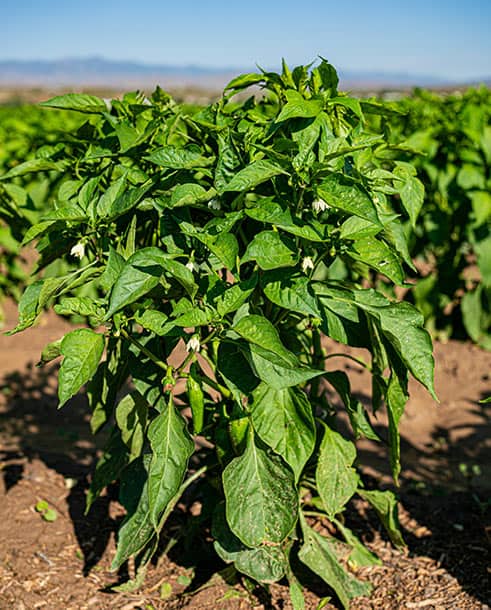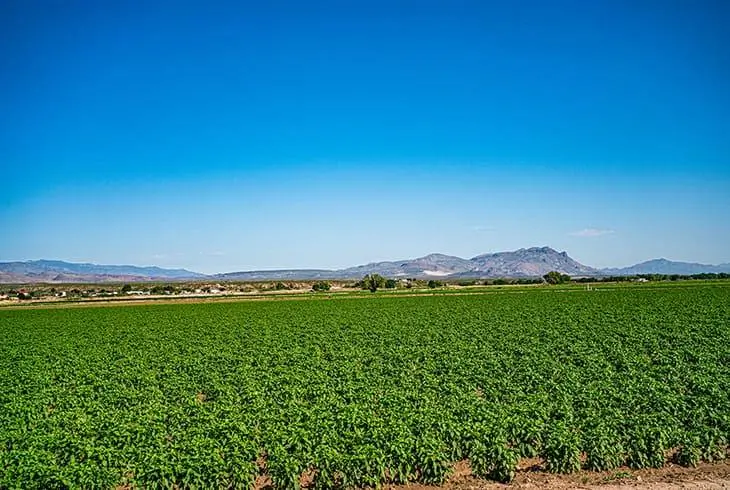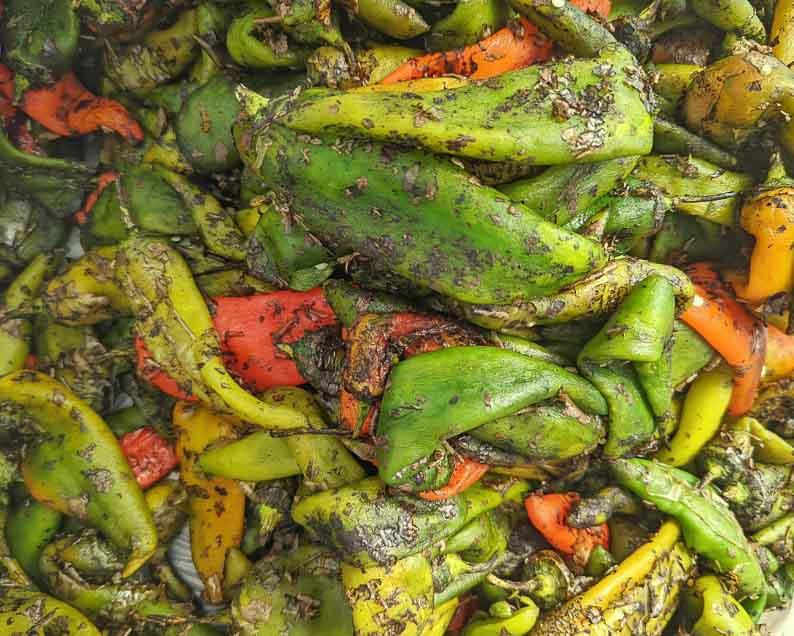Your cart is currently empty!
A Comprehensive Guide to Growing New Mexico Chile

Growing New Mexico or “Hatch” chile peppers can be a rewarding experience for both home gardeners and farmers. Known for their unique flavor and versatility in various culinary dishes, these peppers require specific conditions and care to thrive. In this comprehensive guide, I’ll walk you through the step-by-step process of growing New Mexico chile peppers, from preparation to harvest.
Terroir
Hatch chile and the Rio Grande valley in New Mexico is quite famous for a reason. Our chile is developed here for growing here, and New Mexico is the ideal place to grow it. That being said, it can be difficult to buy New Mexico chile where you are, especially if you are outside the continental US. Different regions have different climate and soil conditions, which will affect what phenotypes the plants produce. Your chile might be smaller, more curved, or some other issue. That being said, following this guide should ensure you have some delicious chile to roast up for a great green chile sauce this growing season!

Preparation
Setting the Stage: Site Selection and Soil Preparation
Location, Location, Location: New Mexico chile peppers are sun-worshippers. Select a location offering at least 8 hours of direct sunlight daily. South-facing slopes are ideal, capturing maximum sunshine throughout the growing season, especially in the later season. In case you are gardening in the Southern Hemisphere, reverse this advice. Ensure the site is well-protected from strong winds that can damage delicate plants.
Soil Secrets: Chile peppers thrive in well-drained, sandy loam soil with a slightly acidic pH between 6.0 and 6.8. Conduct a soil test to determine your soil’s pH and nutrient levels. For soils with a higher pH, adding sulfur or wood ash can help achieve the desired acidity. If your soil is heavy clay, amend it with compost or aged manure and some vermiculite and perlite to improve drainage and aeration. Aim for a soil rich in organic matter, providing essential nutrients for healthy plant growth.
The Mineral Mix: While a balanced fertilizer will provide most essential nutrients, some minerals deserve special attention. Calcium is crucial for preventing blossom end rot, a common problem in chile peppers. Amend your soil with gypsum or crushed limestone if calcium levels are deficient. Potassium, vital for fruit development and disease resistance, can be supplemented with potassium sulfate or wood ash.
Test the soil pH to ensure it falls within the range of 6.0 to 7.0, as New Mexico chile peppers prefer slightly acidic to neutral soil. If the pH is too high or too low, you can make amendments to adjust it accordingly. Keep in mind that the plants themselves and breakdown of soil components affect the pH level, and it should be checked regularly.
Seed Selection
Select what chile varietals you want to grow based on your heat tolerance and what you are looking for in your chile. In case you want something mild, Numex 6-4 is a good one. If you are looking for a straight chile with medium heat and lots of meatiness, Big Jim is perfect for you. If you want something more hot, but still relatively meaty, I recommend Miss Junie. In case you want to grow red chile to tie into a chile ristra, Sandia is a great variety. If you are looking for something hotter, consider the extra hot Barker or xxx-hot Lumbre, but keep in mind that hotter New Mexico chile is generally more difficult to grow.
Planting
When it comes to planting New Mexico chile peppers, timing is crucial. Wait until the danger of frost has passed and the soil has warmed up to at least 60°F (15°C). Pepper plants thrive in warm temperatures, so planting them too early can stunt their growth.
Personally, I like to germinate plants indoors in small seedling pellets. I recommend putting about 3-4 seeds in every pellet, then selecting the strongest plant that grows in the group. The other seeds which germinate should be pinched off, ensuring that your plant with the best genes has a great chance of success. If there is any tip to follow, this one is perhaps the easiest and most beneficial. Strong plants can survive in sub-optimal conditions, but weak plants won’t.
Start by digging a hole that is slightly larger than the root ball of your pepper plant. Place the plant in the hole, ensuring that it is at the same depth as it was in the container. Backfill the hole with soil, firming it gently around the base of the plant.
Space the pepper plants approximately 18 to 24 inches apart to allow for adequate air circulation and prevent the spread of diseases. If you want to plant in pots, select a decent sized pot of at least a few gallons. I’ve grown plenty of chile using cheap 5 gallon buckets for growing on rooftops of apartment buildings in several different countries.
Watering
New Mexico chile peppers are moderately drought-tolerant but require consistent moisture during fruit development. Aim for deep watering every few days, allowing the soil to dry slightly between irrigations. If your pots are small, you will need to water more frequently. Try to water from the bottom if possible and not hit the leaves or flowers to prevent fungal issues. Drip irrigation is an excellent option, delivering water directly to the root zone.
Vegetative Phase
Applying a layer of organic mulch around the base of the plants can help conserve moisture, suppress weeds, and regulate soil temperature. I personally don’t do this, but it is a good step if you can’t tend to your garden every day. Additionally, consider using a balanced fertilizer to provide the necessary nutrients for optimal growth. Follow the manufacturer’s instructions for application rates and frequency.
Pruning the pepper plants can also encourage bushier growth and increase fruit production. Pinch off the top few inches of the plant once it reaches a height of 8 to 10 inches. This process is called topping, and is loved and hated by many people. It is optional, and I recommend trying it on one plant and not trying it on another to see which works best for you!
Throughout the growing season, ensure your chile peppers receive ample sunlight. Remove any weeds competing for resources like sunlight and nutrients. For bushier plants with increased support for developing fruits, pinch off flower buds during the first few weeks after transplanting. These practices will encourage more vegetative growth, resulting in a more productive and fruitful plant.
Harvest
New Mexico chile peppers are typically ready for harvest 3-4 months after planting, depending on the variety. The peppers should have reached their desired size and color, which varies depending on the specific cultivar. If you want green chile, be sure not to harvest it too early. Although green chile is not fully ripe, it needs to ripen enough so the fruit has enough time to develop. It should be firm, not tender. Tender chile doesn’t roast or peel properly.
Using a sharp pair of scissors or pruning shears, carefully cut the peppers from the plant, leaving a short stem attached. Be cautious not to damage the remaining fruit or the plant itself. The bane of farmers around New Mexico is careless pickers who break off stems and leaves of the plant when they harvest. Remember, during the fruiting time, the plant is more focused on producing chile peppers than vegetative growth. It will have difficulty repairing broken stems and leaves. Harvesting regularly encourages the plant to continue producing more peppers throughout the season.

Common Problems and Solutions
Pest Infestation
One common problem faced by home gardeners and farmers when growing chile peppers is pest infestation. Aphids, spider mites, and caterpillars are among the pests that can damage the plants and reduce yield.
To address this issue, regularly inspect your plants for any signs of pests. If you notice an infestation, you can try using insecticidal soaps or organic pest control methods. Introducing beneficial insects, such as ladybugs or lacewings, can also help control pest populations.
Disease Outbreaks
Diseases, such as fungal infections and bacterial wilt, can affect the health and productivity of New Mexico chile pepper plants. Proper sanitation practices and preventive measures are crucial in minimizing the risk of disease outbreaks.
Avoid overhead watering and ensure good air circulation around the plants. Remove any infected plant material and dispose of it properly. Applying fungicides or bactericides as a preventive measure may be necessary in severe cases.
Inadequate Fruit Set
If your New Mexico chile pepper plants are not setting enough fruit, several factors could be at play. Insufficient pollination, extreme temperatures, or a lack of nutrients may contribute to this issue.
To improve fruit set, consider hand-pollinating the flowers using a small brush or gently shaking the plants to release pollen. Protecting the plants from extreme heat or cold with shade cloth or row covers can also help. Ensure that the plants are receiving adequate water and nutrients throughout the growing season.
Improper Soil Chemistry
pH: If the pH is wildly out of balance, it can cause the plant to be unproductive, and either not set fruit, only grow small fruit, impact the vegetal growth, and many more problems.
Minerals: If the plant is lacking calcium, blossom end rot is very common. It is arguably the most common issue with growing chile in New Mexico, and even experienced farmers have this problem. It is better to over mineralize than under mineralize, as long as proper pH and soil drainage are maintained.
Hatch that Chile!
Growing New Mexico chile peppers requires careful attention to detail, from soil preparation to harvest. By providing the right growing conditions, regular care, and addressing common problems promptly, you can enjoy a bountiful harvest of flavorful peppers. Remember to experiment with different varieties and cooking techniques to fully appreciate the unique taste and versatility of New Mexico chile. Be sure to check out our recipes section for ideas about what to cook with your home grown chile peppers!
You will get out what you put into growing chile. Chile is overall a fairly hardy plant species. That being said, if you aren’t on point with your growing, the green chile will often be lackluster and not really roast up well. If you have this problem, I recommend letting the chile ripen to red and sun dry. Doing this will allow you to still enjoy the fruit of your labor, as mature red chile is more forgiving than unripe green chile. Red chile sauce is a huge part of New Mexican cuisine too! For further reading on growing chile, I highly recommend checking out this resource from the Chile Pepper Institute at NMSU in Las Cruces, NM.
Finally, if you aren’t ready to grow your own chile this year and are just reading for curiosity, feel free to stop by during chile season and get roasted chile or a chile ristra this year at 2010 Eubank Blvd NE. You can take some seeds out of raw or dried red chile pods and try growing it next year! We are a convenient Hatch chile shop near you, so come check us out during chile season 2025!
Happy growing!
